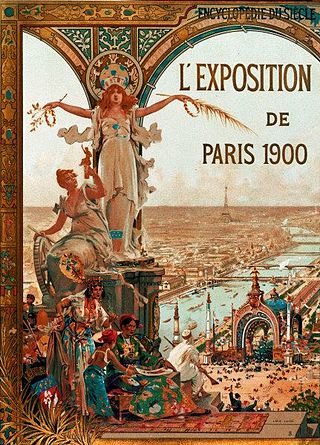
The Exposition Universelle of 1900, better known in English as the 1900 Paris Exposition, was a world's fair held in Paris, France, from 14 April to 12 November 1900, to celebrate the achievements of the past century and to accelerate development into the next. It was held at the esplanade of Les Invalides, the Champ de Mars, the Trocadéro and at the banks of the Seine between them, with an additional section in the Bois de Vincennes, and it was visited by more than 50 million people. Many international congresses and other events were held within the framework of the exposition, including the 1900 Summer Olympics.

The Exposition Universelle of 1889 was a world's fair held in Paris, France, from 5 May to 31 October 1889. It was the fourth of eight expositions held in the city between 1855 and 1937. It attracted more than thirty-two million visitors. The most famous structure created for the Exposition, and still remaining, is the Eiffel Tower.
Jean-Antoine-Gabriel Davioud was a French architect. He worked closely with Baron Haussmann on the transformation of Paris under Napoleon III during the Second Empire. Davioud is remembered for his contributions to architecture, parks and urban amenities. These contributions now form an integral part of the style of Haussmann's Paris.

Henri Sauvage was a French architect and designer in the early 20th century. He was one of the most important architects in the French Art nouveau movement, Art Deco, and the beginning of architectural modernism. He was also a pioneer in the construction of public housing buildings in Paris. His major works include the art nouveau Villa Majorelle in Nancy, France and the art-deco building of the La Samaritaine department store in Paris.

The Fountains in Paris originally provided drinking water for city residents, and now are decorative features in the city's squares and parks. Paris has more than two hundred fountains, the oldest dating back to the 16th century. It also has more than one hundred Wallace drinking fountains. Most of the fountains are the property of the municipality.

The Brussels International Exposition of 1910 was a world's fair held in Brussels, Belgium, from 23 April to 1 November 1910. This was just thirteen years after Brussels' previous world's fair. It received 13 million visitors, covered 88 hectares and lost 100,000 Belgian francs.

Eugène Alfred Hénard was a French architect and a highly influential urban planner. He was a pioneer of roundabouts, which were first introduced in Paris in 1907.

The Passage Jouffroy is a covered passages of Paris, France, located in the 9th arrondissement. It runs between the Boulevard Montmartre to the south and the Rue de la Grange-Batelière to the north.
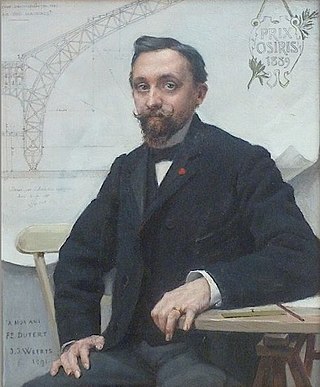
Charles Louis Ferdinand Dutert was a French architect.

The Galerie des machines was a pavilion built for the 1889 Exposition Universelle in Paris. Located in the Grenelle district, the huge pavilion was made of iron, steel and glass.
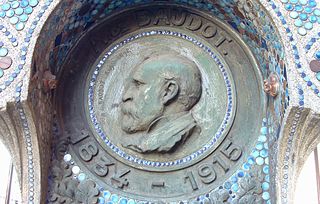
Joseph-Eugène-Anatole de Baudot was a French architect and a pioneer of reinforced-concrete construction. He was a prolific author, architect for diocesan buildings, architect for historical monuments, and a professor of architecture. He is known for the church of Saint-Jean-de-Montmartre in Paris, the first to be built using concrete reinforced with steel rods and wire mesh.

Édouard-Jean Niermans was a famous Dutch-born French architect during the Belle Époque.
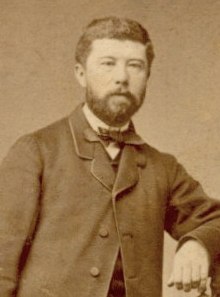
Gabriel-Auguste Ancelet was a French architect who undertook various projects for the Emperor Napoleon III, and later taught for many years at the École des Beaux-Arts in Paris.
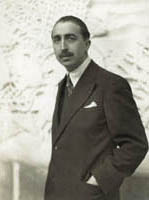
Albert Laprade was a French architect, perhaps best known for the Palais de la Porte Dorée. During a long career he undertook many urban renewal projects as well as major industrial and commercial works. A skilled artist, he published a series of sketch books of architecture in France and other Mediterranean countries.
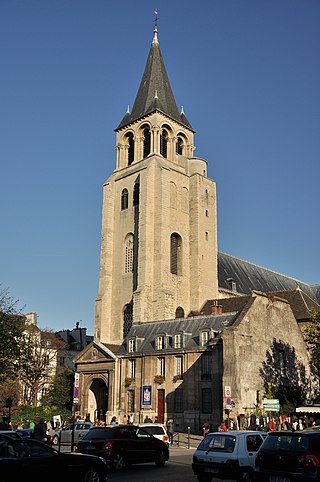
The city of Paris has notable examples of architecture of every period, from the Middle Ages to the 21st century. It was the birthplace of the Gothic style, and has important monuments of the French Renaissance, Classical revival, the Flamboyant style of the reign of Napoleon III, the Belle Époque, and the Art Nouveau style. The great Exposition Universelle (1889) and 1900 added Paris landmarks, including the Eiffel Tower and Grand Palais. In the 20th century, the Art Deco style of architecture first appeared in Paris, and Paris architects also influenced the postmodern architecture of the second half of the century.

Frantz Jourdain was a Belgian architect and author. He is best known for La Samaritaine, an Art Nouveau department store built in the 1st arrondissement of Paris in three stages between 1904 and 1928. He was respected as an authority on Art Nouveau.

Louis Bernard Bonnier was a French architect known for his work as an urban planner for the city of Paris. He was instrumental in loosening the restrictions on the appearance of buildings in Paris, which resulted in the blossoming of Art Nouveau buildings. He designed many significant buildings himself, including private villas, public housing and railway buildings. In all his work he was true to the rationalist principles of Art Nouveau.
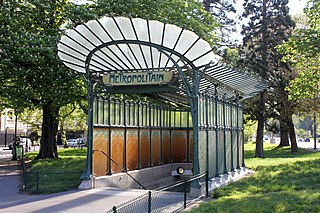
The Art Nouveau movement of architecture and design flourished in Paris from about 1895 to 1914, reaching its high point at the 1900 Paris International Exposition. with the Art Nouveau metro stations designed by Hector Guimard. It was characterized by a rejection of historicism and traditional architectural forms, and a flamboyant use of floral and vegetal designs, sinuous curving lines such as the whiplash line, and asymmetry. It was most prominent in architecture, appearing in department stores, apartment buildings, and churches; and in the decorative arts, particularly glassware, furniture, and jewelry. Besides Guimard, major artists included René Lalique in glassware, Louis Majorelle in furniture, and Alphonse Mucha in graphic arts, It spread quickly to other countries, but lost favor after 1910 and came to an end with the First World War.
Jules-Isidore Lafrance was a French sculptor.

Baron Edmond Jean de Pury was a Swiss painter and engraver.



















